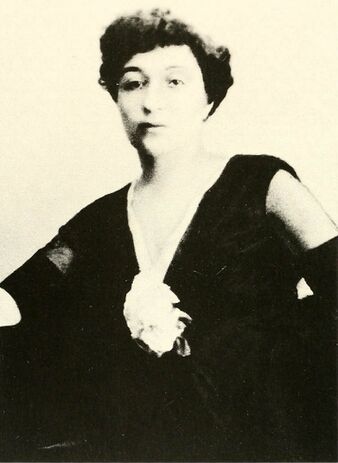Aleksandra Ekster
Jump to navigation
Jump to search
 Aleksandra Ekster, c.1912 | |
| Born |
January 6, 1882 Białystok, Grodno Governorate, Russian Empire (now Poland) |
|---|---|
| Died |
March 17, 1949 (aged 67) Fontenay-aux-Roses, near Paris, France |
| Web | Wikipedia |
Aleksandra Aleksandrovna Ekster (Russian: Александра Александровна Экстер, Ukrainian: Олександра Олександрівна Екстер; 1882–1949), also known as Alexandra Exter, was a Cubo-Futurist, Suprematist, Constructivist painter and designer.
Chronology[edit]
- 1882 born to a wealthy Belarusian family.
- 1892-99 attends the St. Olga Women's Gymnasium in Kyiv.
- 1898 moves with her parents to Kyiv.
- 1901-03 attends the Kyiv Art Institute.
- 1904 marries her cousin, Nikolai Ekster, a lawyer.
- 1906-08 reenrolls in the Kyiv Art Institute.
- 1908 begins visiting Paris and other European cities.
- 1908 takes part in several Kyiv exhibitions, including the avant-garde show The Link; produces her first book illustrations.
- 1909-14 travels and lives abroad frequently; becomes acquainted with Apollinaire, Braque, Picasso, Soffici, and many other members of the international avant-garde.
- 1910 contributes to The Triangle and Union of Youth exhibitions in St. Petersburg.
- 1910-11 contributes to the first Jack of Diamonds exhibition in Moscow.
- 1912-13 moves to St. Petersburg; continues to contribute to major exhibitions. 1913-14 lives mainly in France.
- 1915 influenced by Kazimir Malevich and Vladimir Tatlin, begins to investigate non-objective painting.
- 1915-16 contributes to the exhibitions Tramway V and The Store.
- 1916-17 begins her professional theater work with designs for Thamira Khytharedes in 1916 and Salomé in 1917, both produced by Alexander Tairov at the Chamber Theater, Moscow.
- 1918 Nikolai Ekster dies.
- 1918-19 opens her own studio in Kyiv, among her students are many artists who later achieve success, such as Isaak Rabinovich, Pavel Tchelitchew, and Alexander Tyshler.
- 1918-20 works intermittently in Odessa as a teacher and stage designer.
- 1920 moves to Moscow; marries Georgii Nekrasov, an actor; works at the Theater of the People's House.
- 1921 contributes to the exhibition 5x5=25 in Moscow.
- 1921-22 teaches at VkHUTEMAS; contributes to First Russian Art Exhibition in Berlin, which travels to the Stedelijk Museum in Amsterdam the following spring.
- 1923 turns to textile and fashion design for the Atelier of Fashions in Moscow; is a member of the design team for the Izvestiia Pavilion at the All-Union Agricultural Exhibition in Moscow; begins work on the costumes for Yakov Protazanov's movie Aelita.
- 1924 emigrates to Paris; contributes to the Venice Biennale; works for Russian ballet companies with Léon Zack and Pavel Tchelitchew; teaches at Fernand Léger's Académie Moderne.
- 1925 contributes to the Exposition Internationale des Arts Décoratifs et Industriels Modernes in Paris; continues to work on stage design and interior design (which she will do throughout the 1920s and 1930s): designs costumes for seven ballets performed by Bronislava Nijinska's Théatre Choréographique.
- 1927 exhibition at Der Sturm, Berlin.
- 1929 exhibition at Galerie des Quatre Chemins, Paris.
- 1936 illustrates several elegant children's books, beginning with her own Mon Jardin (1936).
- 1937 exhibition at the Musée des Arts et Métiers, Paris.
- 1949 dies in Paris.
Catalogues[edit]
- Alexandra Exter, ed. Andrei Nakov, Paris: Galerie Jean Chauvelin, 1972, 63 pp. (French)
- Exter, Goncharova, Popova, Rozanova, Stepanova, Udaltsova: Amazons of the Avant-Garde, eds. John E. Bowlt and Matthew Drutt, New York: Solomon R. Guggenheim Museum, 2000. (English)
- Aleksandra Ekster: Tsvetovyie ritmy / Alexandra Exter: Farbrhythmen [Александра Экстер: Цветовые ритмы], ed. Georgii Kovalenko, St Petersburg: Palace Editions, 2001. (Russian)/(German)
- Alexandra Exter: The Stage is a World, forew. Peter Doroshenko, Kyiv: Rodovid Press, and New York: The Ukrainian Museum, 2024, 231 pp. Essays: Ivan Kozlenko, Oksana Semenik, Claire Staebler. Publisher, [1]. (Ukrainian)/(English)/(French)
Literature[edit]
- John E. Bowlt, "The Marionettes of Alexandra Exter", Russian History 8, 1981, pp 219-232. (English)
- Miuda Yablonskaya, "Alexandra Exter", in Yablonskaya, Women Artists of Russia's New Age, 1900-1935, trans. Anthony Parton, New York: Rizzoli, 1990, pp 117-140. (English)
- Ian Christie, "Down to Earth: Aelita Relocated", in Inside the Film Factory: New Approaches to Russian and Soviet Cinema, eds. Richard Taylor and Ian Christie, Routledge, 1991, 81-102, n227-232. (English)
- Georgii Kovalenko (Георгий Ф. Коваленко), Aleksandra Ekster. Put khudozhnika. Khudozhnik i vremya [Александра Экстер: Путь художника. Художник и время; Alexandra Exter: The Artist's Way. Artist and Time], Moscow: Galart, 1993, 287 pp. (Russian)
- Georgii Kovalenko, "Alexandra Exter", in Amazons of the Avant-Garde, eds. John E. Bowlt and Matthew Drutt, New York: Solomon R. Guggenheim Museum, 2000, pp 130-154. (English)
- Georgii Kovalenko (Георгий Ф. Коваленко), Aleksandra Ekster / Alexandra Exter [Александра Экстер], 2 vols., Moscow: Muzej sovremennogo iskusstva, 2010, 303 & 361 pp. (Russian)/(English)
- Jordan Tobin, "Alexandra Exter 1908–1914: Futurist Influences from Russia and the West", in International Yearbook of Futurism Studies. Vol. 5, ed. Günter Berghaus, Berlin: De Gruyter, 2015, pp 252-265. (English)
- Lesia Turchak, "Vnesok Oleksandry Ekster u khudozhniu kulturu Ukraїny ta svitu" [Внесок Олександри Екстер у художню культуру України та світу], Suchasne Mystetstvo [Сучасне мистецтво] 17, 2021, pp 219-228. (Ukrainian)
- Valentyna Chechyk, "Alexandra Exter theatre and Ukrainian scenography in the 1910s and 1920s", Theatralia 25:1, 2022, pp 44-64. (English)

